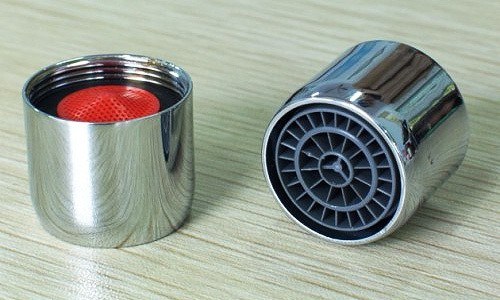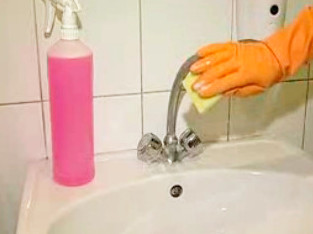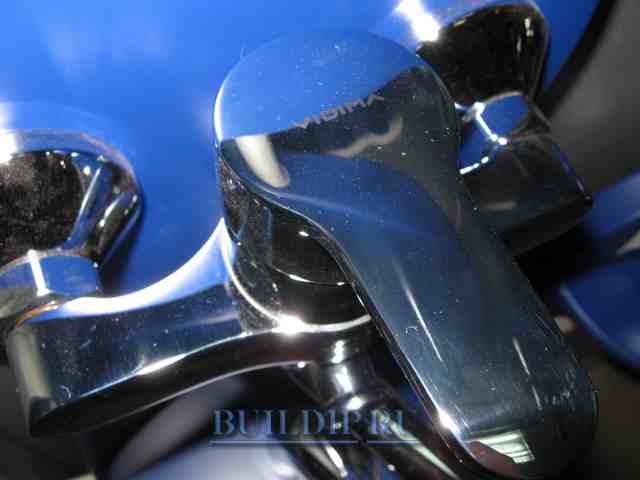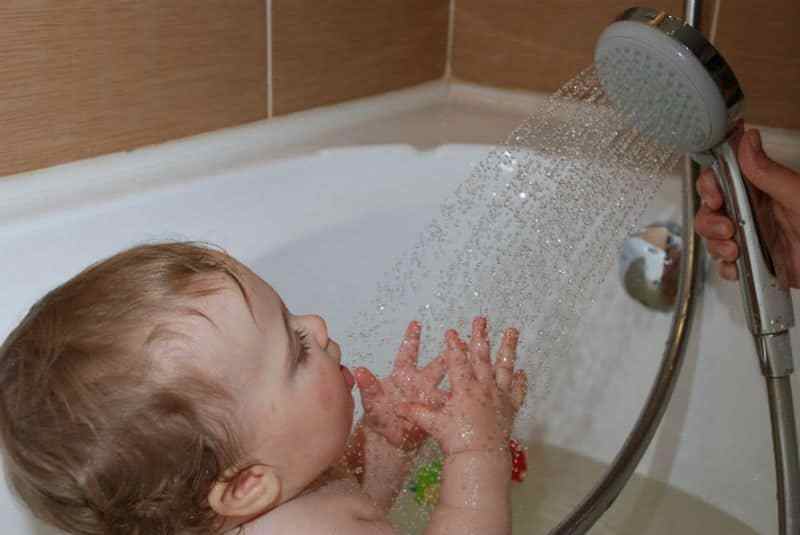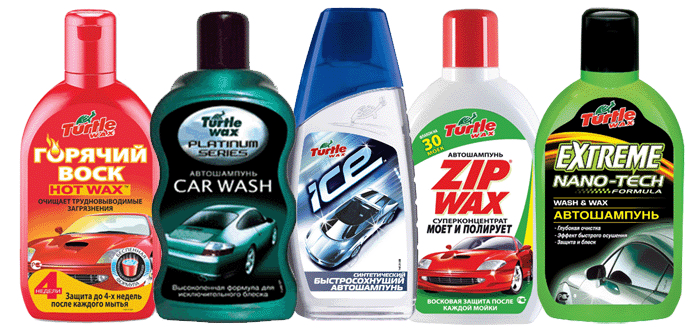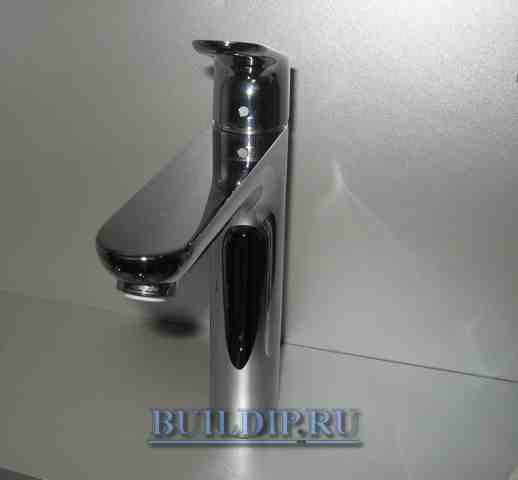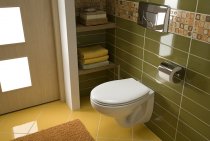Household chemicals in the fight against water stone
The easiest way to get rid of growths of water stone and soap scum is to resort to modern household chemicals. But when using such strong and aggressive products, the following facts must be taken into account:
- Clean plumbing only with chemicals approved for the specific material.
- Metal faucets and faucets with decorative enamel (made from unusual materials) can easily be damaged using aggressive cleaners.
- Never use scouring powders and bleaches designed to clean the bathroom, sink and washbasin.
- Most faucets are treated with chromium, which reacts very strongly to acids. The metal begins to blacken, burnt spots appear on it, which will be impossible to remove.
Carefully study the composition of cleaning products. They should not contain sulfuric, phosphoric and hydrochloric acids, as well as chlorine.

We clean the aerator
Cleaning soap deposits on the outside of the faucet is only half the battle. Modern faucets are equipped with aerators - this is a small metal nozzle with a mesh on the faucet spout. This little detail serves to enrich the water with oxygen, due to which it performs a number of useful functions:
- Reduces the noise level of flowing water, due to the fact that many small bubbles soften the flow of water.
- Reduces spatter.
- Additional filtration from small debris, which occasionally happens in tap water.
- The aerator helps by maintaining good pressure with minimal water consumption. Savings depending on the model can range from 50 to 80%.
It often happens that the aerator becomes clogged with lime flakes and ceases to cope with its functions qualitatively. In this case, it must be removed and cleaned.
How to understand that it is time to clean the aerator:
- The faucet is fully open, but the water barely flows
- Water flows unevenly, the flow either intensifies or weakens
- There is water in the system, but it does not pass through the mesh holes
For work, we need pliers, a rag and a container with a detergent composition.
Carefully wrap the nozzle with a rag, clamp with pliers and turn clockwise. And here, an unpleasant surprise awaits the owners of cheap Chinese plumbing: aerators for such mixers are most often made of extruded aluminum or plastic coated with a shiny coating, both materials are fragile and often break when you try to unscrew them. If the aerator burst during dismantling - do not despair, get a new one. Made of steel or brass, quality plumbing aerators last much longer.
If the nozzle is stuck, then use WD-40
or vinegar, wet a cloth, wrap it around the nozzle, wrap it with a plastic bag on top and leave until the thread mobility is restored, this is about 2-3 hours.
After you have unscrewed the aerator, rinse it from large contaminants under a tap, and then place it in a glass with 9% vinegar. The exposure time depends on the degree of contamination and varies from 1 to 12 hours. After the time has elapsed, rinse the aerator with clean water, if necessary, clean the holes with a darning needle.
Collect the clean nozzle and screw it into place, you do not need to tighten it so that you can easily unscrew it with your fingers at any time and wash it. It is advisable to remove and rinse the nozzle once a week, then the aerator will work properly.
Preventive actions
Even with increased water hardness, contamination of the faucet will not be a problem if the plumbing equipment is properly maintained. For example, you can apply the following methods:
- install water softener filters;
- install coarse and fine mechanical filters;
- Use suitable cleaning agents;
- remove lime deposits while they are fresh;
- cover the outer surfaces with a special shampoo that forms a film that protects against dirt.
Then maintaining the good condition of the equipment will not be a hassle.
Using the methods described, any skilled owner will be able to clean the mixer. To do this, you need a screwdriver, a wrench and a special tool for removing rust and lime deposits. The main thing is not to forget to close the shut-off valves for hot and cold water before starting work. All these efforts will not go in vain. A smooth, powerful jet from the tap will help you quickly and easily complete all household chores.
Each person at least once in his life faced with the problem of how to remove limescale from a tap, but few people thought about the true reasons for its appearance. The fact is that in the water that is supplied to our houses and apartments through pipeline systems, there are always various mineral impurities. Their number may vary depending on the area of residence, but they still exist and have a direct impact not only on water hardness, but also on the formation of an unpleasant plaque on the internal and external surfaces of pipeline equipment. In this article, we will tell you how to clean a limescale faucet at home and how to avoid further contamination.
Methods for cleaning a nickel-plated or chrome-plated faucet
Such surfaces require careful maintenance. They need to be properly cleaned and disinfected. You can wash the mixer with the help of some means:
Dishwashing liquid. Take 1 glass of warm water and mix 1 tablespoon in it. detergent
Then take a sponge impregnated with the prepared solution and carefully clean all parts of the structure.
Please note: the spout, base, levers and faucet valves should be thoroughly cleaned

Baking soda. To clean rust off a chrome bathroom faucet, you will need baking soda. Take a soft sponge and lightly dampen it with water, you can also use a cloth. With their help, spread the soda over the surface and leave it for 30 minutes. After that, the soda can be washed off with cool water.
White vinegar. Pour white vinegar (6%) into the spray bottle and spread it over the surface of the product, the mineral deposits will begin to dissolve. Leave drops of vinegar on for 10 minutes. Then the mixer must be wiped with a dry cloth.
Folk remedies
Despite the abundance of different types of household chemicals, folk remedies that are easy to prepare at home are still popular. These are solutions and pastes based on lemon, soda, vinegar or other products.
Lemon
This type of citrus fruit has long been used as a natural cleanser due to its high acid content. The fruit must be cut into two halves, the cut side should be treated with chrome surfaces and wait 10 minutes until the acid destroys the salt deposits. Then wipe the mixer with a dry and soft cloth dry. Citric acid can be an effective alternative. In a specially prepared container
- pour out a small amount of crystalline substance;
- add some water;
- mix everything thoroughly until completely dissolved;
- soak a soft sponge in the solution;
- clean affected areas.

Soda
To use this product, soda slurry is prepared. The cooking process is simple and does not take much time:
- put a few tablespoons of the powder into a cup;
- dilute it with a little water;
- mix until smooth;
- hold for up to 5 minutes to dissolve large abrasive particles.
When the paste is ready, it should be applied to the chrome parts of the washbasin and left for an hour.After that, the product must be carefully removed with a soft cloth, without effort. If stains remain, they can be wiped off with light movements using a soft sponge.
Vinegar
Acetic solutions are another popular cleaner option. The composition may include table vinegar with a 9% concentration or its apple counterpart. An obligatory component is water, which is mixed with vinegar in equal parts. After cooking
- the sponge is moistened with a solution;
- handle plumbing;
- wait a few minutes;
- using a soft cloth, wipe everything dry.
The solution immediately reacts, allows you to quickly get rid of lime deposits, and the absence of abrasive properties protects the sensitive surface from scratches.

Coca Cola
Since the appearance of this overseas drink in the former USSR, housewives quickly discovered its amazing ability to clean pollution. In this case, no preparatory procedures are required, it is enough
- soak a piece of cloth in soda;
- put it on the sink faucet;
- hold the compress for about 20 minutes;
- wash the treated surface from the remnants of pollution and drink;
- wipe with a dry cloth.
The acids that make up Cola destroy the water stone, restore the shine of the surface without damage.
Laundry soap
- grind the soap into shavings;
- dissolve with a little hot water;
- add some baking soda;
- mix the components until a slurry with a homogeneous consistency.
The mixture is applied in a continuous layer over the entire surface of the tap and kept for about an hour. To finally clean it from the remnants of scale, you will need to rinse everything with running water.

natural remedies
Unfortunately, allergies are becoming one of the most common diseases in the world. Often, an allergic reaction is caused by household chemicals. In such cases, you can try to clean the faucet and faucets in the bathroom using simple, natural methods.
-
Baking soda.
Dip a slightly damp washcloth in baking soda and wipe the surface with it. Wash off with water. -
Soap solution.
Dissolve laundry soap in hot water. The resulting thick solution cleans limescale well. If you add a spoonful of soda to the soap solution, the effectiveness will increase. -
Lemon acid.
You can take crystalline citric acid, but it is better to clean the mixer with half a lemon. If you dip a slice of lemon in fine salt, the process will become even easier. Citric acid must be washed off well. -
A weak solution of vinegar, table or apple.
Prepare a solution by diluting half the 9% table vinegar. Dampen a soft cloth or brush in it and clean the faucet in the bathroom and in the kitchen. Rinse with water.
Taps in hard-to-reach places can be cleaned with a soft toothbrush. Great for cleaning chrome surfaces in the bathroom, special microfiber cloth.
Handy tools
If you do not have the opportunity to use special formulations, due to the high cost or allergies to household chemicals, then we resort to the help of folk remedies.
First you need to make it a rule, after using the mixer, wipe it with a dry cloth every time - and there will be nothing to clean. But, you see, it is difficult, all the same haste, lack of time, or simply mother laziness. Therefore, we will consider care options that will replace expensive products for us.
Lemon or citric acid, which many people use to clean kettles from lime deposits. Effective and proven tool. But do not use a concentrated solution, if it is a whole lemon, but slightly diluted juice with water. And so it is better to use the liquid that remains after boiling and cleaning the kettle, but already warm, and not boiling water.
Removable chrome parts, such as an aerator, can be soaked in this solution for 10 minutes.
Advice.Avoid contact with marble products.
Baking soda is good at removing grease and lime deposits. But it should also be diluted with water to a mushy consistency, otherwise you will scratch the product.
Mustard powder diluted with water, or mustard. Try this remedy on hidden places before use. There is little information about its reaction with chromium, but it is not so popular either.
Baby body oil well removes soap and grease stains, as well as non-resistant lime deposits.
What you use to clean the faucet is up to you, but remember, saving on care products can turn into a completely uneconomical replacement of the entire faucet.
Descalers
For adherents of household chemicals on the market there is a huge selection of cleaning products for cleaning the tap or mixer from limescale.
Tip: when buying a special powder, carefully read the label. Otherwise, there is a risk of saying goodbye not only to plaque, but also to your own plumbing.
Anti-corrosion inhibitors
Cheap detergents do not contain valuable anti-corrosion inhibitors. Inhibitors prevent aggressive additives from damaging the metal. With them, the entire attack is directed exclusively at lime deposits. Therefore, look for in the composition of the product: anti-corrosion inhibitors.
Sulfuric, hydrochloric or nitric acid
Acids are heavy artillery for cleaning a faucet. They decompose not only plaque and rust, but also enamel and metal coatings. Means with such acids can be used only in advanced cases and only with gloves on the hands.
For daily processing, it is better to choose softer products - based on surfactants
. When they get into the water, they are almost completely biodegradable, and also do not damage the skin of the hands.
What to choose: liquid or cleaning agent?
The powder has an abrasive structure and is best used for cleaning bathtubs and sinks. It is better to entrust the care of metal surfaces to liquid products. Apply the product on the surface, leave for 5-10 minutes, rinse with water. And enjoy the glitter!
In tap water
contains minerals
, from
them
depends on its hardness
and
will become mixers during operation.
impurities
settle on pipes and taps, limescale is formed. Faucet care includes not only daily wiping from moisture, but also regular cleaning of mineral deposits inside and out.
outside.
What can not be cleaned
The top layer of mixers is very easy to spoil. And it will no longer be the product that attracts with its brilliance and specularity. Chromium, as a chemical element, reacts with various kinds of acids and their compounds. Thus, the surface is destroyed, darkens, tarnishes. What acids are not used? Oxalic, acetic, orthophosphoric, chloride and others.
Carefully read the annotations for cleaning products, they should be specifically for chrome products. For example, I had to deal with such an advertised remedy as Silit. After using it, the shower head became covered with dark spots. It is designed to remove lime deposits, but not from chrome surfaces!
Also do not use abrasive, powdery substances for care. It is because of their consistency that the coatings are damaged. It is clear that micro scratches cannot be avoided during operation, but they do not need to be specially created.
For cheap low-quality products, at the site of chips and damage, not only the top layer is erased, but also the inner one. As a result, the same lime, chlorine, soap solution gets into them, which leads to further destruction. Eventually some of the chrome may peel off.
You can not use sponges with a hard surface, for the same reason - they leave scratches.In hard-to-reach places, use a toothbrush, but again with soft bristles. And so, the best sponge with microfiber or a simple cloth.
Use of household chemicals
You can also clean the faucet of limescale with the help of specially designed cleaning products that are sold in every household chemical store. However, there are a few very important things to keep in mind when choosing and using chemicals:
In this article, we have shared with you the most effective methods for removing limescale from a faucet, and we sincerely hope that following these recommendations will help keep your plumbing clean.
Housewives are well aware of the problem of calcification of chrome-plated plumbing fixtures. To restore their former appearance, one has to look for effective means that allow you to remove limescale from the tap quickly and without damaging its surface.
The reason for the occurrence of limescale is associated with a high content of calcium and magnesium salts in the water. When the faucet is open, especially hot water, it forms steam, which condenses and forms a coating. In the absence of timely care, it crystallizes over time, turning into a persistent white scale, which is difficult to remove with ordinary wiping.
How to clean shower head holes
If the holes of the hydromassage nozzle are clogged, we will use heated vinegar, by the way, vinegar is a universal home remedy that housewives use for various purposes. With it, you can, rooms and even from various kinds of household pollution.
Unscrew the shower head, disassemble it into parts and soak them in heated vinegar for 1-2 hours, then, armed with a darning needle, carefully clean all the holes, and assemble everything as it was. Instead of vinegar, you can use "CilitBang
and an old toothbrush. When the limescale is gone, assemble the watering can and attach it back to the hose.
Wax shampoo
Some housewives have found a way not only to wash the taps, but also to protect the chrome parts from limescale for a week. To do this, they use a wax car wash shampoo. This tool is designed to protect the body of the car from adverse weather conditions. The wax in the shampoo forms a thin water-repellent film on the surface that protects the metal from corrosion. You can buy wax shampoo at any auto shop.
Put a drop of shampoo on the sponge and thoroughly wash all the chrome surfaces of the kitchen and bathroom. Buff with a soft cloth or microfiber cloth to a mirror finish. That's all, you can forget about limescale for at least a week.
Restoration of darkened plumbing
Perhaps I will upset the readers, but it is impossible to restore the chrome coating at home. However, it is possible to significantly improve the appearance of a faucet damaged by acid or chlorine and partially restore its lost luster. To do this, use a polishing paste for chrome parts of a car, for example: "AREXONS Mirage Cromature Brillanti
» (Italy), Goi pasta
(made in the USSR) or other similar tool. A wide selection of such products is available in any car shop, ask the seller and he will advise you on the right polish.
It is necessary to apply the paste on the damaged surface and polish it with a piece of felt for a long time, if the house has a grinder with a felt nozzle, then the work will go much faster. Since the coating is already damaged, then a similar procedure will have to be repeated from time to time.
Glittering faucets are in every kitchen and every bathroom. These are absolutely necessary technical devices in the economy. In addition, stylish faucets in classic or modern design have long been a decoration of the interior.
Suddenly, the faucet begins to hiss and snort, and the jet loses pressure. The reason for this may be deposits of calcium contained in tap water. To eliminate the breakdown, the mechanism must be thoroughly cleaned and defective parts replaced.
Traditional faucets are equipped with two separate valves for cold and hot water. Recently, they are gradually being replaced by single-lever designs. Which of the models is preferable in terms of design and technical device, everyone chooses for himself.
Double valve

- worm;
- lamellar;
- ball.
When we turn the valve, the locking mechanisms open the way for the corresponding flow. After passing through the faucet box, the water is mixed in the spout.
single lever
A special cartridge is built into the body of such a mixer, which contains two ceramic plates ground to each other. When the handle-lever is turned, the plates are displaced relative to each other. This expands or closes the holes through which water passes.
There is also a model where the plates are replaced by a hollow ball with holes. Hot and cold streams enter, mixing, into this chamber and through the outlet enter the tap spout. The control lever moves the ball, thus regulating the pressure and temperature of the water.
ball
For installation in the bathroom, the faucets can be equipped with a ball switch. It allows you to redirect the flow of water between the shower and the gander, i.e., the spout of the tap. Structurally, this device is close to the ceramic crane box. Adjustment is made by rotating a small lever.
This mechanism is extremely reliable and less prone to breakage, unlike another popular variety - a push-button shower switch.
Is it possible to avoid the formation of plaque
Avoid the appearance of plaque inside the tap will not work. Although, in different regions of our country, water has different hardness, but it still contains a certain amount of magnesium and potassium salts that form plaque.

But it is quite possible to restore external beauty and shine if you make it a rule to wipe the mixer after use. For this purpose, a napkin or the soft side of a sponge is suitable.






Tap water always contains minerals. In some regions there are more of them in the water, in others they are much less, but they are definitely there. Not only the hardness of the water, but also the condition of your mixer depends on their quantity. It is because of mineral salts that whitish spots of matte limescale appear on the shiny surface of a chrome-plated faucet. No self-respecting hostess will leave this disgrace without attention. How to clean the faucet in the bathroom so as not to damage its surface?
Chemicals
A more effective way to remove the stone is the use of household cleaners. It is advisable to use products specifically designed for stainless steel surfaces with a chrome finish. Popular drugs include
- Russian Sanoks, for metal plumbing and products with a ceramic base for a similar purpose;
- Ravak Cleaner Chrome from a Czech manufacturer for chrome-plated equipment;
- well-known to domestic housewives Cif from Hungary, designed for metal cleaning;
- another domestic drug Cillit Bang effectively removes salt deposits from metal parts;
- German Top House is designed to care for the sink in the kitchen and other stainless steel equipment.
A necessary and general condition for the use of these compounds is the protection of the skin, in some cases the eyes and respiratory organs. For other details of use, please refer to the label or the accompanying instructions, if available.For a final shine, you can use polishes, which, among other things, are able to create a film that prevents calcification. These substances include Indesit and Dumax.

This information will be useful for novice housewives who do not always know how to clean the faucet from limescale of varying complexity at home.
How to avoid plaque
In full accordance with the saying “prevention is better than cure”, it is much easier to prevent the occurrence of calcium deposits than to suffer with its removal. There are three main preventive measures that can solve this problem:
- wipe the faucet after each use, preferably dry;
- carry out regular cleaning at least once a week;
- to prevent the flow of plumbing, in a timely manner to eliminate malfunctions.
Liquid or solid products: which is better to use
For a knowledgeable person, such a dilemma does not exist. The choice should be unambiguously in favor of liquid preparations that spare the surface. Most powders are abrasive and can damage surfaces.
Should You Use a Water Filter?
According to user reviews, filters are really a useful thing. They remove excess salts and soften the water, reducing the chance of deposit formation. There are reagent and non-reagent varieties. When choosing the first option of filtering devices, you will have to regularly spend money on updating the reagent. The second one is more economical, despite the additional power consumption, and is not inferior to reagent counterparts in terms of efficiency. Another plus of the electromagnetic option is the ability to act equally on cold and hot water.
A little bit of science
To begin with, let's study a little what a chrome surface is. In our view, we are always talking about a shiny and mirror structure. Visually, everything is correct, but from the point of view of electroforming, everything is much more complicated. Chromium itself is not used in its pure form; in the process of applying it to the surface of products, its compounds (solutions) are used. Moreover, chromium plating is carried out on the so-called sublayer, which can be a thin film of copper or nickel. Thus, the resistance of such a surface to destruction is significantly increased. The component of almost all high-quality mixers is presented as follows: the base is brass, the sublayer is nickel and chrome on top.
On cheap products made of silumin, chromium plating is difficult to implement, so special varnishes are widely used. This product has nothing to do with real chrome, which can be distinguished by a cool blue tint.
In general, when choosing a faucet for a bathroom or kitchen, be guided by the weight of the device and the shade of its surface.
Methods for getting rid of limescale
Modern household chemicals are the simplest and most common method of cleaning plaque on bathroom faucets. But the use of such funds has several nuances. To prevent damage to faucets and faucets, only use cleaning fluids that are suitable for them.
Under no circumstances should rust removers or bleaching agents be used. Chrome, which is usually coated with plumbing, is very active. When interacting with acid, it begins to break down. This results in dark spots that are difficult to remove. Before using household chemicals, it is always necessary to study its composition. Liquids for chrome products must be free of chlorine, hydrochloric, phosphoric, sulfuric acids.
Do not use powdered cleaners for cleaning. Abrasive particles can compromise the integrity of the coating.
After using each product, it must be thoroughly rinsed with water, especially before applying the next.Otherwise, a chemical reaction between different agents may damage the product. Protective gloves must be used to prevent injury to hands. If you need to remove plaque inside the product, it should be disassembled. If this fails, then it is enough to disconnect the tap and soak it for 30 minutes in an acetic solution, then rinse it.
Folk remedies
You can also clean plaque at home with folk remedies:
- 1.
One of the most common ways to clean a product from plaque is to use a metal scraper. This product is designed to remove old food or solids from dishes. The shape of the mesh allows you to remove dirt even in hard-to-reach places. But at the same time, it is recommended to use special gloves for washing, so as not to damage the skin of the hands. The only drawback of the scraper is that with strong pressure, there is a chance of leaving marks and scratches on the mixer. - 2.
The use of table salt allows you to remove limescale in a few minutes. To do this, just pour salt on a damp cloth and rub the surface of the plaque. If the raid is not more than a year, then it will not be difficult to remove it. At the same time, there will be no marks or scratches on the faucet. - 3.
The use of lemon is also quite effective, but it is necessary to remember the harmful effects of acids. To clean, rub the plaque area with lemon and leave for 20 minutes. To enhance the effect, you can first rub it with a rag with salt, and then with lemon. After the time has elapsed, the resulting solution is washed off with cold water and wiped with a dry cloth. By the same principle, you can use citric acid by dissolving it in water. - 4.
The use of baking soda allows not only to remove limescale, but also to add shine to the chrome surface of the mixer. The principle of use is similar to the use of salt. You need to pour soda on a damp cloth, rub the surface of the plaque, then rinse everything off and wipe it dry. If the plaque is not removed the first time, you can repeat the procedure, but leave the soda on the mixer for two hours. To make the soda better absorbed, you can apply it with a soft brush. - 5.
The easiest way to remove dirt is with vinegar. There are several options for doing this: apply the solution to the mixer and cover with cling film or soak a rag in vinegar and leave it on the tap for 30 minutes. Be sure to rinse the vinegar thoroughly after cleaning. Shower heads can be removed and placed in a plastic bag along with a weak acid solution.
Cleaning the aerator and shower head
It is not enough to clean only the outer surface of the faucet. Limescale also accumulates inside.
Over time, it can cause plumbing failure.
In modern mixers, aerators are installed - meshes on the faucet spout. When this part is clogged, it must be removed and cleaned.
Signs that the aerator is clogged:
- when the faucet is fully open, the water pressure becomes very weak;
- water runs unevenly, the flow periodically increases;
- the most neglected case - water does not flow, although it is in the system and the tap is open.
Aerator cleaning steps:
- First you need to unscrew the faucet nozzle. To do this, you need to wrap it with a rag, clamp it with pliers and turn it clockwise. On cheap Chinese plumbing, aerators made of plastic or aluminum are usually installed. Therefore, they break when unscrewing the nozzle. In this case, you should buy a new aerator from a plumbing store. A quality part can be made of brass or steel and will last much longer than before.
- If the nozzle does not unscrew, then you can put an vinegar compress on it. After a few hours, mobility will be restored.
- The unscrewed aerator should be cleaned of large debris with running water.
- Then place the product in a container with 9% vinegar and leave for 1-12 hours, depending on the contamination.
- After the allotted time, rinse the aerator under running water and carefully clean the holes with a needle.
- The cleaned nozzle should be collected and screwed into place.
It is recommended to rinse the aerator once a week, then the cleansing will be much faster.
Often the holes in the hydromassage nozzle are clogged. You can clean the shower head with warm vinegar. For this you need:
pour table vinegar into a container and heat it;
soak the parts of the disassembled shower head in warm vinegar;
leave for 1-2 hours;
after this time, rinse the parts with running water and carefully clean the holes with a needle;
collect the watering can and screw it back.
Dealing with old limescale is not an easy task. It can damage the faucet. To prevent this, you need to regularly clean plumbing from plaque. Then it will serve the owner for many years.
How to clean a faucet from rust, scale and other contaminants
In order to clean the mixer from rust, scale and other contaminants, you can use a variety of chemicals. It is not recommended to use compounds containing aggressive acids and chlorine. You also need to be careful with abrasive powders so as not to damage the chrome surface.
Cleaning products
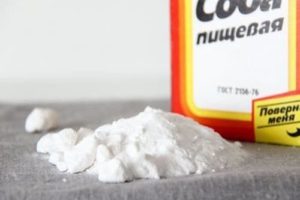
Please note that ordinary bath and toilet gels, as well as bleaches, are not suitable for cleaning faucets from the inside. The most popular home remedies are:
The most popular home remedies are:
- laundry soap;
- lemon acid;
- baking soda.
Do not mix different products, as you can accidentally get a caustic composition that will damage the metal. Before cleaning, put on rubber gloves to protect your hands from harmful effects.
How to clean a faucet
In the presence of light plaque, you can simply rinse the device with an appropriate agent. If deposits have penetrated deeply, you will have to remove and disassemble the entire mixer. Coarse dirt and rust from the internal parts can be cleaned with a steel wool.
When cleaning external chrome surfaces, abrasive powders should be avoided.
If it is not possible to disassemble the mixer, then it can be soaked in detergent for several hours, in the hope that the build-up of lime inside the device will dissolve or become brittle and fall off on its own. But do not leave metal products in solution for too long.
Limescale removal
Lime deposits are formed due to the high content of calcium in the water. Hard water enters the water supply network quite often. White spots and stains can be easily removed from the surface of the mixer with laundry soap or soda. In the presence of persistent contamination, they can be covered for a while with a cloth soaked in vinegar or a solution of citric acid, then rinse the part with clean water. For the treatment of internal surfaces, it is better to use special tools.
Rust removal
If there is a significant amount of rust, it must first be cleaned off with a metal brush or sandpaper. The remaining traces, as well as slightly affected areas, are treated with the usual means: vinegar, soda, lemon juice.
You can try to wipe off the rust with a rag soaked in machine oil or kerosene. Car owners use an auto cleaner for this purpose, or you can buy a special household anti-rust agent in the store.
How to clean the aerator filter
The cause of a weak uneven jet from the tap may be a clogged aerator filter.It is often clogged with small debris contained in the water. In addition, the fine mesh is also susceptible to salt deposits and rust. The aerator is carefully unscrewed and immersed in a solution of vinegar. Then it is rinsed and set in place.
If the filter is so "grown" to the tap that it is impossible to remove it, the cleaning solution is poured into the bag. This package is hung on a crane, immersing the part of the device to be cleaned into it.
In the video, the author tells what components of the mixer need to be checked in order to improve the water supply.
